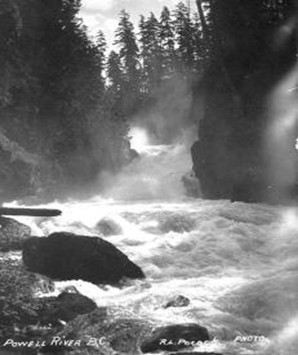From Fostering Local Industry to 100% Exports – a brief history of local hydro
Since the construction of the pulp and paper mill in 1911, Powell River’s history has been shaped initially by rapid industrial growth and, more recently, by deindustrialization.
This history has also been bound up with hydroelectric power. Hydro was essential to the mill’s early success. The mill was originally located here due to ideal conditions for generating hydro to meet the high energy demand of the pulp and paper industry. As noted in The Powell River Digester (August 1925):
“The industry here is made stable and permanent by reason, to a large degree, of a complete and thoroughly adequate power development.”
The Powell River Company built the mill and the dams and initially provided free electricity to millworker homes in Townsite. By the 1920’s, the Powell River mill was one of the world’s top newsprint producers, earning Powell River the title of “newsprint capital of the world”. (“Powell River’s Historic Mill Marks 100 Years of Operation”, Vancouver Sun, March 31, 2012)
To power the mill, the province granted extensive water licenses allowing river diversion, water storage, and land flooding in the Powell and Lois watersheds. Four dams were built – Powell River, Lois, Horseshoe, and Theodosia. These dam projects destroyed fish habitat and in some cases displaced people—most significantly the Tla’amin Nation from their village tiskwat.


Powell River before the dam
2001 - The Mill Begins Divesting Its Power Assets
In 2001 the mill’s owners were given permission to sell off half of their hydro assets to Powell River Energy Inc. (PREI) on the understanding that they would invest to modernize the mill. In 2013 PREI, which was by then a Brookfield subsidiary, acquired the unsold assets and assumed full control.
Starting in 2001, the mill had power purchase agreements with PREI, guaranteeing them a secure supply of power. PREI was allowed to sell to other buyers any power that was surplus to the mill’s needs.
However, in May 2021 the power purchase agreement expired and PREI subsequently began selling all the power it generated to the US electricity market. Catalyst, the mill’s owners at the time, cited the loss of guaranteed power as one reason for their decision to close the mill.
Both Catalyst and the Tla’amin Nation complained to the federal regulator that PREI had not explored opportunities for the power to be used locally – contrary to “Fair Market Access” requirements - before applying for a ten-year blanket export permit. In October 2022, PREI withdrew this application but power exports to the US from its dams continue through one of Brookfield’s other companies.
Since 2021 PREI has sought to avoid regulation by the BC Utilities Commission, first requesting exemptions and then a full exclusion. After BCUC ruled they do not qualify for an exclusion, PREI appealed to the BC Supreme Court in 2024. As of May 2025, the Court had not ruled on this appeal.
Timeline of Key Events
The timeline entries for 1910-1956 come from Bill Thompson’s book, The Powell River Mill Story, which provides a detailed history of the mill and the dams.
1910 - 1913 - Construction of the original Powell River dam, related infrastructure, and mill. The dam was raised in 1924 to produce more power for the mill, increasing the reservoir capacity by an additional 14 feet. (Bill Thompson, The Powell River Mill Story, 2016)
1930 - 1931 A log crib dam and power generating and transmission infrastructure were constructed at Lois Lake in order to allow the mill to expand. In 1940-41 the concrete Scanlon dam replaced the original dam.
1935 – An earthfill dam was constructed on Horseshoe Lake.
1955 - 1956 – The Theodosia River was diverted to feed Powell Lake, involving a dam, weir, dykes, and connecting canals.
2001 - Pacifica Papers, the owners of the mill at the time, sold 50% of its hydro assets to Powell River Energy Inc (PREI) for $100 million. (https://www.bclaws.gov.bc.ca/civix/document/id/mo/hmo/m0026_2001) PREI was granted some exemptions from the BC Utilities Commission Act and is allowed to sell power surplus to what the mill needed to other buyers.
2013 - PREI acquired the remaining 50% from Catalyst for “C$33 million plus the assumption of related debt.”(https://www.sec.gov/Archives/edgar/data/1533232/000119312513251892/d405483df1.htm)
2015 - PREI applied for, and is granted, an exemption from BCUC’s Mandatory Reliability Standards program. (https://www.ordersdecisions.bcuc.com/bcuc/orders/en/item/120321/index.do?q=PREI)
2021 - May: Catalyst and PREI fail to agree on a new power purchase agreement.
September: PREI applies to the BC Utilities Commission for exemptions from the Utilities Commission Act, saying that now all of the energy it is generating qualifies as “Surplus Power” - energy that that is no longer used at the mill. Tla’amin Nation, ED4BC, and local residents make submissions opposing this application. PREI subsequently withdrew its application. (https://docs.bcuc.com/Documents/Proceedings/2021/DOC_64660_B-1-PREI-Exemption-Application.pdf)
December: Catalyst permanently closes the mill, citing the uncertainty about access to power. (https://www.prpeak.com/local-news/indefinite-curtailment-announced-for-catalyst-paper-tiskwat-mill-4819274)
December: PREI applies to the Canada Energy Regulator for a ten-year blanket export permit to export all the power that it generates. PREI’s asks to be allowed to export far more electricity than the existing capacity of the dams. (https://docs2.cer-rec.gc.ca/ll-eng/llisapi.dll/fetch/2000/90466/94151/4195297/4195298/4177174/C16878-7_Application_for_a_Blanket_Electricity_Export_Permit_-_EN_-_A7Z7S0.pdf?nodeid=4176619&vernum=-2) The Tla’amin Nation, Catalyst, and ED4BC oppose the granting of this permit. PREI subsequently withdraws this application.
2022 - PREI registers under BCUC’s Mandatory Reliability Standards program. (https://docs.bcuc.com/documents/AnnualReports/2024/BCUC-F2022-23-Annual-Report.pdf)
2023 - PREI argues for a complete exclusion from regulation by the BC Utilities Commission.
The City of Powell River, local residents and community groups write letters opposing this exclusion. Jim Quail of Allevato Quail & Roy is retained as legal counsel for ED4BC to argue against PREI’s request to be excluded.
The BCUC panels ruled against PREI. PREI then requested that BCUC reconsider its decision. BCUC upholds its decision, and PREI then applies in 2024 to the BC Court of Appeal to get BCUC’s ruling overturned. As of May 2025, the Court had not ruled.
ed4bc@shaw.ca
© 2025. All rights reserved.
